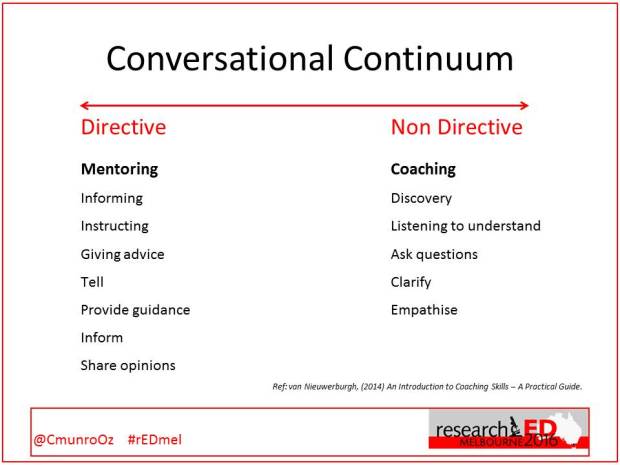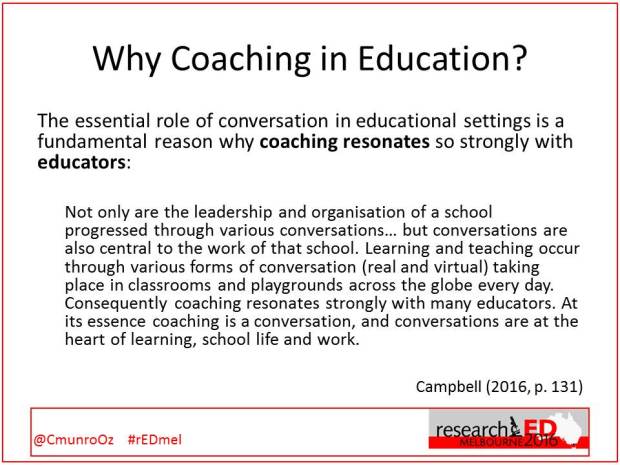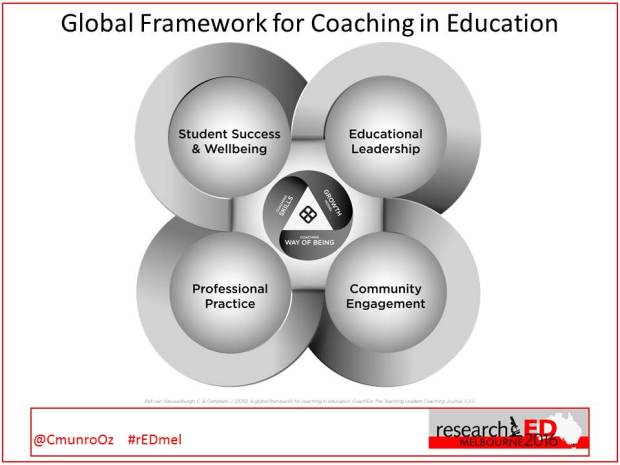I recently had the privilege of presenting at the researchED Melbourne event. For this presentation I decided to take more of a “big picture” view of coaching rather than discussing the developmental story that I had done a few times before. Through my ongoing involvement in coaching and seeing how it is evolving at my own school and many others that I know, I have become increasingly interested in how the introduction of coaching as an “initiative” might affect a change in organisational culture over time.
I’m a little late in getting around to this but I thought that it might be useful to write a commentary to some of the slides that I used at researchED.
It is important to begin by clarifying what we mean when we talk about coaching and the definition below sums it up perfectly for me.

The terms coaching and mentoring are often used in the same breath and their meaning conflated in educational discourse. Unfortunately, this only serves to perpetuate the confusion that exists about the difference between the two. A useful way to distinguish between these two forms of “helping intervention” is to place them on a continuum as shown on the slide below.

The key difference between coaching and mentoring is one of intent – what is expected, invited or solicited when entering into each of these collaborative engagements with another. This post on the #educoachOC blog explores this topic in more detail.
So why coaching in education? This quote from John Campbell speaks for itself and resonated strongly with me when I thought back to my early interest in coaching in schools.

Starting Points
Schools provide a range of “conversational contexts” (Campbell, 2016, p. 133) where coaching approaches can improve outcomes. When we first think about introducing coaching, we might identify a problematic conversational context as a starting point. This could sound something like “We want to change the nature of conversations around ‘x’ so that ‘y’ will improve”. It’s not too difficult to identify a wide range of contexts like this in schools.
Alongside these conversational contexts the introduction of coaching may be driven by a more general philosophical view of teaching and of teacher learning such as the moral imperative argued by Wiliam (2014, p. 6). It may be about a view of teacher professionalism.
We need to create environments in which teachers embrace the idea of continuous improvement…an acceptance that the impact of education on the lives of young people creates a moral imperative for even the best teachers to continue to improve.
Van Nieuwerburgh and Campbell have proposed a Global Framework for Coaching in Education as a way of considering the range of entry points or “portals” for the introduction of coaching and coaching approaches in schools.

Entering through the Professional Practice portal could mean a focus on classroom teaching, with a desire to create a safe space for dialogue about the reality of what is happening in teachers’ classes leading to more discerning and personalised professional learning. Entering through the Educational Leadership portal could be about focusing on the nature of performance and development conversations that leaders have with their teams with a desire to both improve the leadership capacity of the leaders themselves and make these conversations more developmental in nature. Approaching coaching through the Student Success and Wellbeing portal could be about employing coaching approaches with students, or between students, in order to enable them to better articulate their learning and to set goals and identify strategies to help move them forward. Just as with school leaders, equipping students with coaching skills might also develop their leadership capacity. The Community Engagement portal invites us to consider broadening the application of coaching approaches further still to involve parents, carers and other community partners involved in learning and development conversations.
When we propose the introduction of something like coaching we may not yet have an entirely clear vision of what it will look like in practice across the school, but chances are, we will know what is driving us to pursue it. This rationale for the introduction of coaching in a school context is key to its success and is an important area for schools to examine.
So, if coaching is seen to be the answer, what is the question? I have explored this question in a previous post.
A Word of Caution
Coaching is about unlocking potential (Whitmore, 2009, p. 10). At its best, coaching is empowering and respectful and aims to build capacity and efficacy. However, it can be tempting for school leaders to view coaching as an appropriate response to perceived teacher under-performance or non-compliance. Coaching is not a cure to be administered to teachers or a manipulative strategy to ensure compliance. In fact, “stealth coaching” by leaders (or anyone else for that matter) risks engendering feelings of mistrust of the true intent of coaching and those leading it. This issue is ultimately about our beliefs about our colleagues’ capacity for professional growth and our respect for their professionalism.

Context is Key
Whenever I’ve had discussions (online and in person) with colleagues in other schools about the why and how of coaching in their context, they invariably refer to the contextual conditions that exist(ed) in their school. These are things like the customs, routines, processes, levels of collaboration, leadership, and the nature of discourse about practice in the school. Any and all of these can have a positive or negative influence on how coaching “lands” with staff and on its rate of growth.
The pre-conditions for coaching will be different in every school context. Coaching leaders need to be in tune with these and take them into account when considering their approach. Trust is a critical factor here. We know that trust is critical in individual coaching relationships but in terms of establishing a broader coaching culture we need to think about the levels of trust across the full range of conversational contexts in the school.
Some Questions
- Through which ‘portal’ are you approaching coaching?
- What conversational context do you want to enhance with coaching and/or coaching approaches?
- How does your rationale for initiating coaching sit with the true intent and principles of a coaching approach?
- Thinking about the prevalent discourse in your school: is it one of trust, growth, ownership, empowerment and learning, or is it one of performativity, judgement, deficit, suspicion and compliance?
- How might this influence how, when and with whom you introduce coaching in your context?
Part 2 will consider my own school context and the emergence of what we could call the “embryonic signs” of a coaching culture.
Further Reading
Towards a Coaching Culture (free book chapter): https://au.sagepub.com/sites/default/files/upm-binaries/74874_vanNieuwerburgh_Towards_a_Coaching_Culture.pdf
References
Campbell, J. (2016). Coaching in schools. In C. van Nieuwerburgh (Ed.) Coaching in Professional Contexts. London: Sage.
van Nieuwerburgh, C. (2012). Coaching in education: an overview. In C. van Nieuwerburgh (Ed.) Coaching in Education: Getting Better Results for Students, Educators, and Parents. London: Karnac.
van Nieuwerburgh, C. (2014). Introduction to Coaching Skills: a practical guide. London: Sage.
van Nieuwerburgh, C., & Campbell, J. (2015). A global framework for coaching in education. CoachEd: The Teaching Leaders Coaching Journal, February 2015: 2-5.
van Nieuwerburgh, C. (2016). Towards a coaching culture. In C. van Nieuwerburgh (Ed.) Coaching in Professional Contexts. London: Sage.
Whitmore, J. (2009). Coaching for performance: GROWing human potential and purpose: The principles and practice of coaching and leadership (4th edn.). London: Nicholas Brealey.
Wiliam, D. (2014). The formative evaluation of teaching performance. CSE Occasional Paper No. 137. Melbourne: Centre for Strategic Education (CSE).
Great article Chris – particularly how coaching might look within each “portal”
LikeLike
Thanks Sophie. I appreciate you taking the time to read it and comment. You’ve played a key role in the Part 2 story 😄
Catch up soon.
LikeLike